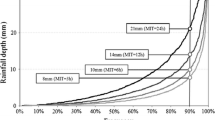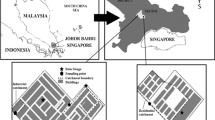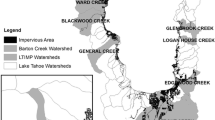Abstract
Stormwater runoff can represent a significant source of pollutants to downstream water bodies. An integrated assessment was conducted for the Spring Lake watershed in western Michigan because of concerns that increased impervious land cover in the watershed, especially in sub-basins adjacent to Spring Lake, would result in greater stormwater runoff and pollutant loads. Spring Lake has a history of high total phosphorus (TP) concentrations and cyanobacterial blooms. An alum treatment, paid for by an assessment, was applied to Spring Lake in 2005 to control internal phosphorus loading; hence, there was an economic incentive for stakeholders to limit new phosphorus from entering the lake, which otherwise would reduce the long-term efficacy of the alum treatment. This study provides a novel six-step process that identifies priority areas and optimally reduces nonpoint sources of pollution. We identified a suite of best management practices to be placed in the watershed, assessed their optimal locations based on pollutant sources, and modeled the degree to which their implementation would reduce TP and total suspended solids. Application of the modeled best management practices (BMPs) resulted in a 15 % reduction in TP load and a 17 % reduction in total suspended solid load. Reductions were not uniform throughout the watershed, with the greatest reductions closest to Spring Lake. We also developed a flow chart for BMP selection, which may be transferable to other watersheds with similar issues.









Similar content being viewed by others
References
Alberti, M., Booth, D., Hill, K., Coburn, B., Avolio, C., Coe, S., & Spirandelli, D. (2007). The impact of urban patterns on aquatic ecosystems: an empirical analysis in Puget lowland sub-basins. Landscape and Urban Planning, 80, 345–361.
Annis water resources institute (AWRI). (2009). Rein in the Runoff: alternative stormwater management practices that address the environmental, social, and economic aspects of water resources in the Spring Lake Watershed (MI). Online URL: http://www.gvsu.edu/wri/director/rein-in-the-runoff-stormwater-integrated-assessment-in-28.htm (accessed February 6, 2015).
Arnold, J. G., Moriasi, D. N., Gassman, P. W., Abbaspour, K. C., White, M. J., Srinivasan, R., Santhi, C., Harmel, R. D., van Griensven, A., Van Liew, M. W., Kannan, N., & Jha, M. K. (2012). SWAT: model use, calibration, and validation. Transactions of the American Society of Agricultural and Biological Engineers, 55, 1491–1508.
Baker, R.J., Wieben, C.M., Lathrop, R.G., & Nicholson, R. S. (2014). Concentrations, loads, and yields of total nitrogen and total phosphorus in the Barnegat Bay-Little Egg Harbor Watershed, New Jersey, 1989–2011, at multiple spatial scales; U.S. Geological Survey Scientific Investigations Report 2014–5072, 64 p.
Beighley, R. E., Dunne, T., & Melack, J. M. (2008). Impacts of climate variability and land use alterations on frequency distributions of terrestrial runoff loading to coastal waters in Southern California. Journal of the American Water Resources Association, 44, 62–74.
Catherine, A., Mouillot, D., Maloufi, S., Troussellier, M., & Bernard, C. (2013). Projecting the impact of regional land-use change and water management policies on lake water quality: an application to periurban lakes and reservoirs. PloS One, 8, e72227.
Chang, C. L., Chiueh, P. T., & Lo, S. L. (2007). Effect of spatial variability of storm on the optimal placement of best management practices (BMPs). Environmental Monitoring and Assessment, 135, 383–389.
Chocat, B., Krebs, P., Marsalek, J., Rauch, W., & Schilling, W. (2001). Urban drainage redefined: from stormwater removal to integrated management. Water Science and Technology, 43, 61–68.
Croke, B. F. W., Ticehurst, J. L., Letcher, R. A., Norton, J. P., Newham, L. T. H., & Jakeman, A. J. (2007). Integrated assessment of water resources: Australian experiences. Water Resources Management, 21, 351–373.
Dodds, W. K., Bouska, W. W., Eitzmann, J. L., Pilger, T. J., Pitts, K. L., Riley, A. J., Schloeser, J. T., & Thornbrugh, D. J. (2008). Eutrophication of US freshwaters: analysis of potential economic damages. Environmental Science & Technology, 43, 12–19.
Domagalski, J. (1996). Pesticides and pesticide degradation products in stormwater runoff: Sacramento River basin, California. Water Resources Bulletin, 32, 953–964.
Dougherty, M., Dymond, R. L., Grizzard Jr., T. J., Godrej, A. N., Zipper, C. E., Randolph, J., & Anderson-Cook, C. M. (2006). Empirical modeling of hydrologic and NPS pollutant flux in an urbanizing basin. Journal of the American Water Resources Association, 42, 1408–1419.
Goodwin, K. (2007). Total maximum daily load for biota for the River Rouge Watershed, including Bishop and Tonquish Creeks Washtenaw. Michigan Department of Environmental Quality, Water Bureau Report, August:Wayne and Oakland counties.
Groffman, P. M., Bain, D. J., Band, L. E., Belt, K. T., Brush, G. S., Grove, J. M., Pouyat, R. V., Yesilonis, I. C., & Zipperer, W. C. (2003). Down by the riverside: urban riparian ecology. Frontiers in Ecology and the Environment, 1, 315–321.
Hillman, T., Crase, L., Furze, B., Ananda, J., & Maybery, D. (2005). Multidisciplinary approaches to natural resource management. Hydrobiologia, 552, 99–108.
Hisschemöller, M., Tol, R. S. J., & Vellinga, P. (2001). The relevance of participatory approaches to integrated environmental assessment. Integrated Assessment, 2, 57–72.
Isely, E.S., Steinman, A.D., Isely, P.N., & Parsell, M.A. (2014). Building partnerships to address conservation and management of western Michigan’s natural resources. Freshwater Science, 33, 679–685.
Jakeman, A. J., & Letcher, R. A. (2003). Integrated assessment and modelling: features, principles and examples for catchment management. Environmental Modelling & Software, 18, 491–501.
Johnson, K., Steinman, A. D., Keiper, W. D., & Ruetz III, C. R. (2011). Biotic responses to low concentration urban road runoff. Journal of the North American Benthological Society, 30, 710–727.
Kaushal, S. S., Groffman, P. M., Band, L. E., Shields, C. A., Morgan, R. P., Palmer, M. A., Belt, K. T., Swan, C. M., Findlay, S. E. G., & Fisher, G. T. (2008). Interaction between urbanization and climate variability amplifies watershed nitrate export in Maryland. Environmental Science & Technology, 42, 5872–5878.
Kennedy, R. H., & Cooke, G. D. (1982). Control of lake phosphorus with aluminum sulfate: dose determination and application techniques. Journal of the American Water Resources Association, 18, 389–395.
King, R. S., Baker, M. E., Kazyak, P. F., & Weller, D. E. (2011). How novel is too novel? Stream community thresholds at exceptionally low levels of catchment urbanization. Ecological Applications, 21, 1659–1678.
Madsen, T., & Figdor, E. (2007). When it rains, it pours: global warming and the rising frequency of extreme precipitation in the United States. Report to Environment Michigan Research & Policy Center. Online URL: http://www.environmentmichigan.org/reports/mie/when-it-rains-it-pours-0 (accessed March 26, 2014).
McFarland, A. M. S., & Hauck, L. M. (1999). Relating agricultural land uses to in-stream stormwater quality. Journal of Environmental Quality, 28, 836–844.
McLellan, S. L., Hollis, E. J., Depas, M. M., VanDyke, M., Harris, J., & Scopel, C. O. (2007). Distribution and fate of Escherichia coli in Lake Michigan following contamination with urban stormwater and combined sewer overflows. Journal of Great Lakes Research, 33, 566–580.
Milstead, W.B., Hollister, J.W., Moore, R.B., & Walker, H.A. (2013). Estimating summer nutrient concentrations in northeastern lakes from SPARROW load predictions and modeled lake depth and volume. PloS One, 8, e81457.
Nejadhashemi, A.P., Woznicki, S.A., & Douglas-Mankin, K.R. (2011). Comparison of four models (STEPL, PLOAD, L-THIA, and SWAT) in simulating sediment, nitrogen, and phosphorus loads and pollutant source areas. Transactions of the American Society of Agricultural and Biological Engineers, 54, 875–890.
Obropta, C. C., & Kardos, J. S. (2007). Review of urban stormwater quality models: deterministic, stochastic, and hybrid approaches. Journal of the American Water Resources Association, 43, 1508–1523.
Parker, J. S., R. Moore, & M. Weaver (2009). Developing participatory models of watershed management in the Sugar Creek Watershed (Ohio, USA). Water Alternatives, 2, 82–100.
Parson, E. A. (1995). Integrated assessment and environmental policy-making. Energy Policy, 23, 463–475.
Patz, J.A., Vavrus, S.J., Uejio, C.K., & McLellan.S.L. (2008). Climate change and waterborne disease risk in the Great Lakes region of the U.S. American Journal of Preventative Medicine, 35, 451–458.
Paul, M. J., & Meyer, J. L. (2001). Streams in the urban landscape. Annual Review of Ecology and Systematics, 32, 333–365.
Rabalais, N. N., Turner, R. E., & Scavia, D. (2002). Beyond science into policy: Gulf of Mexico hypoxia and the Mississippi River nutrient policy development for the Mississippi River watershed reflects the accumulated scientific evidence that the increase in nitrogen loading is the primary factor in the worsening of hypoxia in the northern Gulf of Mexico. Bioscience, 52, 129–142.
Refsgaard, J. C., van der Sluijs, J. P., Højberg, A. L., & Vanrolleghem, P. A. (2007). Uncertainty in the environmental modelling process—a framework and guidance. Environmental Modelling & Software, 22, 1543–1556.
Rosenquist, S. E., Hession, W. C., Eick, M. J., & Vaughan, D. H. (2010). Variability in adsorptive phosphorus removal by structural stormwater best management practices. Ecological Engineering, 36, 664–671.
Roy, A. H., Wenger, S. J., Fletcher, T. D., Walsh, C. J., Ladson, A. R., Shuster, W. D., Thurston, H. W., & Brown, R. R. (2008). Impediments and solutions to sustainable, watershed-scale urban stormwater management: lessons from Australia and the United States. Environmental Management, 42, 344–359.
Scavia, D., & Bricker, S. B. (2006). Coastal eutrophication assessment in the United States. Biogeochemistry, 79, 187–208.
Schueler, T.R. (1994). The importance of imperviousness. Watershed Protection Techniques, 1, 100–111.
Schueler, T., Hirschman, D., Novotney, M. & Zielinski, J. (2007). Urban subwatershed restoration manual no. 3: urban stormwater retrofit practices (version 1). Center for Watershed Protection, http://www.cwp.org/Store/usrm/htm.
Smith V.H., Tilman, G.D., & Nekola, J.C. (1999). Eutrophication: impacts of excess nutrient inputs on freshwater, marine, and terrestrial ecosystems. Environmental Pollution, 100, 179–196. doi:10.1016/S0269-7491(99)00091–3.
Steinman, A. D., & Ogdahl, M. (2008). Ecological effects following an alum treatment in Spring Lake, Michigan. Journal of Environmental Quality, 37, 22–29.
Steinman, A. D., & Ogdahl, M. (2012). Macroinvertebrate response and internal phosphorus loading in a Michigan Lake following alum treatment. Journal of Environmental Quality, 41, 1540–1548.
Syed, A.U., & Jodoin, R.S. (2006). Estimation of nonpoint-source loads to total nitrogen, total phosphorus, and total suspended solids in the Black, Belle, and Pine River basins, Michigan, by use of the PLOAD model. U.S. Geological Survey, Scientific Investigations Report 2006–5071.
Talberth, J. G., Yonavjak, E., & Gartner, L. T. (2013). Green versus gray: nature’s solutions to infrastructure demands. Solutions, 4(1).
Theobald, D. M. (2005). Landscape patterns of exurban growth in the USA from 1980 to 2020. Ecology & Society, 10, 32.
Trim, A. H., & Marcus, J. M. (1990). Integration of long-term fish kill data with ambient water quality monitoring data and application to water quality management. Environmental Management, 14, 389–396.
Tsihrintzis, V. A., & Hamid, R. (1997). Modeling and management of urban stormwater runoff quality: a review. Water Resources Management, 11, 137–164.
U.S. Environmental Protection Agency (2001). PLOAD version 3.0: an ArcView GIS tool to calculate nonpoint sources of pollution in watershed and stormwater projects. User’s Manual, January.
U.S. Environmental Protection Agency (2002). National water quality inventory: report to Congress 2002 reporting cycle. Washington, D.C.. Available: Available online at: http://water.epa.gov/lawsregs/guidance/cwa/305b/2002report_index.cfm. Accessed 2013 October 29.
Van Kerkhoff, L., & Lebel, L. (2006). Linking knowledge and action for sustainable development. Annual Review of Environmental Resources, 31, 445–477.
Walsh, C. J., Roy, A. H., Feminella, J. W., Cottingham, P. D., Groffman, P. M., & Morgan, R. P. (2005). The urban stream syndrome: current knowledge and the search for a cure. Journal of the North American Benthological Society, 24, 706–723.
Wang, L., Lyons, J., Kanehl, P., & Bannerman, R. T. (2001). Impacts of urbanization on stream habitat and fish across multiple scales. Environmental Management, 28, 255–266.
Xie, L., Rediske, R. R., Hong, Y., O’Keefe, J., Gillett, N. D., Dyble, J., & Steinman, A. D. (2012). The role of environmental parameters in the structure of phytoplankton assemblages and cyanobacteria toxins in two hypereutrophic lakes. Hydrobiologia, 691, 255–268.
Zhang, X., Liu, X., Zhang, M., Dahlgren, R. A., & Eitzel, M. (2010). A review of vegetated buffers and a meta-analysis of their mitigation efficacy in reducing nonpoint source pollution. Journal of Environmental Quality, 39, 76–84.
Acknowledgments
This study is dedicated to the memory of Vicki Verplank, a fervent advocate for Spring Lake. The work was funded by a grant from Michigan Sea Grant and the National Oceanic and Atmospheric Administration, as well as by substantial in-kind contributions by the Annis Water Resources Institute at Grand Valley State University. The authors would like to thank the members of the project team, including all of the stakeholders who provided their valuable insight and support. Special thanks are extended to Tim Penning for input on communication products; Sanjiv Sinha, Kelly Karll, and Lisa Huntington from Environmental Consulting & Technology, Inc. (ECT) for engineering expertise on stormwater best management practices; and Paul Isely for expertise on economics. Additionally, the authors would like to thank the individuals who reviewed the final project report and Mary Ogdahl for her constructive comments on the manuscript.
Conflict of interest
The authors declare that they have no competing interests.
Author information
Authors and Affiliations
Corresponding author
Rights and permissions
About this article
Cite this article
Steinman, A.D., Isely, E.S. & Thompson, K. Stormwater runoff to an impaired lake: impacts and solutions. Environ Monit Assess 187, 549 (2015). https://doi.org/10.1007/s10661-015-4776-z
Received:
Accepted:
Published:
DOI: https://doi.org/10.1007/s10661-015-4776-z




